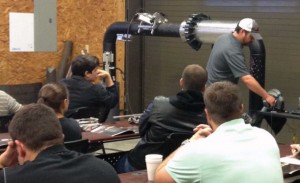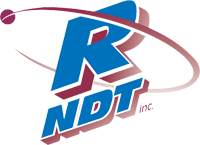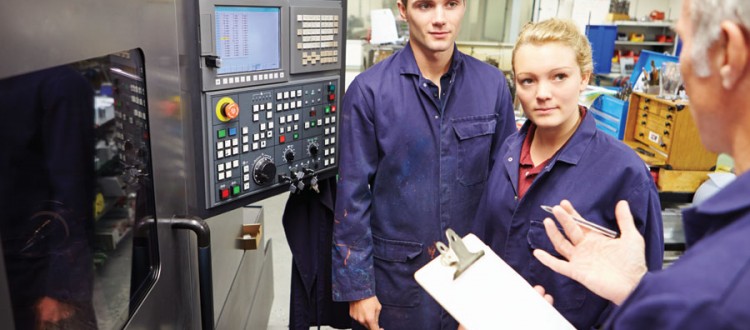It Begins With Training
In today’s advancing nondestructive testing world, NDT training is a crucial part of obtaining certifications, job satisfaction and career growth.
Qualified NDT(Nondestructive Testing) professionals are in high demand in the progressive petrochemical industry, although NDT is a career field that has little to no exposure within the general population. As training facilities emerge to aid in filling the numerous job openings, available exposure to this very rewarding career is beginning to escalate in popularity.
Our NDT personnel require more training to maximize the effectiveness of operation with these ever-changing technologies. NDT is a growing career field, projected to be worth $1720.96 million by 2020, according to Sys-Con Media www.sys-con.com/node/3046174. And with the proper training and certification, technicians can help NDT technology grow by increasing safety and environmental awareness along with satisfying demands for high quality services.
In today’s advancing nondestructive testing world, NDT training is a crucial part of obtaining certifications, job satisfaction and career growth. A great deal of responsibility is placed on our NDT technicians who help keep our aircraft, trains and automobiles operating safely, and our pipelines and chemical plants from having failures and costly down time, with advancements in the equipment and products produced by these industries. The need for a good quality system in each industry is a must to manufacture and maintain functional safe environments for their particular product in each industry. The NDT technicians with proper training will be able to determine which discipline of NDT is best to use for the isolation of anomalies present in the materials under examination. Training can provide the NDT technicians with the theory of how each method works and the advantages and limitations of each method. Training can take the NDT technicians from the theory of each method and teach the technicians how to employ that theory in their day to day inspections to maximize the quality of inspections and be better prepared to deal with special circumstances that often occur in the day to day use of each method.
NDT equipment and methods are constantly changing with new advancements in technology. The basic theory of each method has not changed but how we employ that theory is much more sophisticated. This has dramatically changed how training is performed. With more and more of our instruments being computerized, the requirement to have knowledge of the basic principles of NDT becomes apparent daily in the classroom. Specialized advanced training for use of technological driven instruments is more focused on the computed aspects of each method than the basic theory at this point in the training. Most specialized advanced courses require a prerequisite of training in the basic discipline prior to the advanced course of instruction. With these advancements, an increased amount of knowledge in that particular method is required, leading to some NDT technicians specializing in those particular methods of inspection.
 A well trained and accomplished technician should be able to assess the part under examination and recommend the best method or methods to which the inspection should be performed. After completion of the inspection, if anomalies are present the technician should be able to ascertain the type, approximate size, and shape of the anomalies and provide a detailed report of the findings. As the technician gains more history within a particular industry the technician should be able to asses high problem areas to each component under inspection based on the component’s function, type of material, temperatures, pressures, and any chemicals present. The technician should readily recognize any problematic areas that present unusual circumstances that may require additional methods to accomplish a quality inspection.
A well trained and accomplished technician should be able to assess the part under examination and recommend the best method or methods to which the inspection should be performed. After completion of the inspection, if anomalies are present the technician should be able to ascertain the type, approximate size, and shape of the anomalies and provide a detailed report of the findings. As the technician gains more history within a particular industry the technician should be able to asses high problem areas to each component under inspection based on the component’s function, type of material, temperatures, pressures, and any chemicals present. The technician should readily recognize any problematic areas that present unusual circumstances that may require additional methods to accomplish a quality inspection.
To achieve this level of competency in a technician it begins with training.
Training is a two prong approach which consists of a knowledge base covering theory of process and on-the-job training covering the practical use of each inspection process. Beginning with the knowledge base ASNT (American Society for Nondestructive Testing) issues the CP-105, which in its content is the topical outline for multiple methods covering the subject matter that should be addressed in the training of the entry level technician. The outline of the CP-105 is very beneficial to ensuring all trainees receive the same information; the training should be more structured around the industry that the trainee will be exposed. The training should keep the trainee engaged and inquisitive. The training should include how the theory of each method is applied to the practical inspection. How the indication was formed is the fundamental knowledge required to provide a proper assessment of the inspection performed. Without the ability to transition the theory to the results of the inspection performed, technicians are limited in their ability to address resultant abnormalities. This transition of knowledge to practical application should start in the initial training and continue throughout the technician’s career.
With the introduction of the computer and internet, NDT training can now be achieved by classroom training supplied by an instructor or by web based tutorials. Advancements in software allow instructors to answer the students’ questions online in one-on-one Q&A sessions, increasing the quality of training through computer based training without limiting the quality of the training session.
On-the-job training is where the technician starts to employ the knowledge gained into practical hands-on testing under the supervision of an experienced technician. This allows the technician to perfect the skill set through practical utilization in the field without sacrificing the quality of the examination. This will allow the trainee to begin to build historical information directly related to the industry where the technician is involved, while also gaining some of the knowledge base and history from the experienced technician supervising.
Quality of products is the foundation of all processes in the world. Without good quality products planes would cease to fly, trains would not move, oil and gas could not be produced, limiting automobiles’ movement. NDT technicians aid in ensuring that these products are made correctly and they check the quality of products throughout the service life, while allowing the product to remain in service. These checks allow for increased production of end products through minimizing lost production time and allowing for scheduled maintenance times or providing increased knowledge of replacement intervals.
Safety is improved by ensuring the quality of the component in the processes. Failure of a component can result in catastrophic damages to property and personnel. All component failures cannot be removed from occurring, but with increased inspections can be drastically minimized. This saves lives and property while minimizing unscheduled process downtime and increasing production of end product.
With the ever increasing demand for trained NDT technicians, increased quality requirements of products, higher demands for products, and tighter environmental safety controls, training of NDT technicians will become even more demanding in providing quality technicians to the work environment quickly and efficiently. Doing so means that the effectiveness of the training is ensured with each technician trained.
All of this begins with the proper training of an NDT technician. Training is the base foundation of a technician, and provides the technician with the knowledge to ensure the components examined are of the quality to maintain serviceability safely. A good structure is only as good as the foundation it rests on.
A highly trained technician is an ever increasing valuable asset.
Published in Quality Magazine

